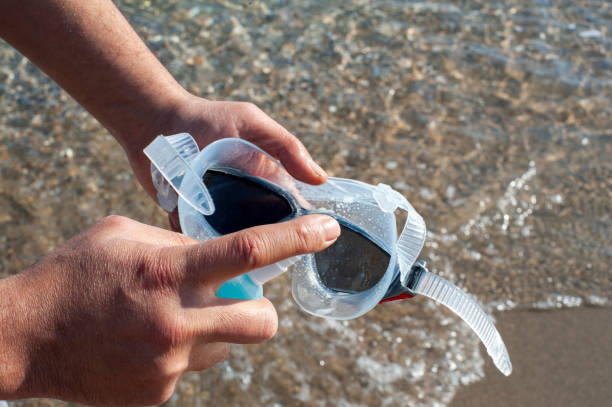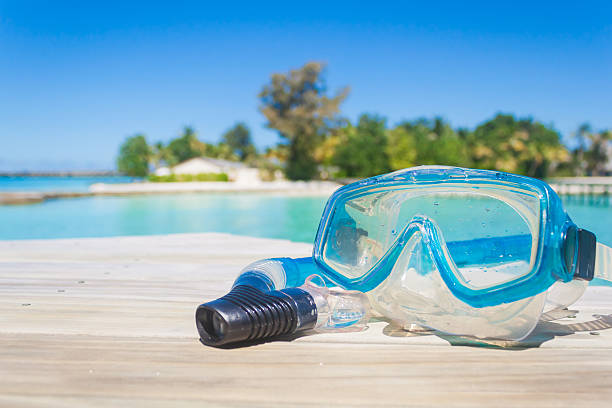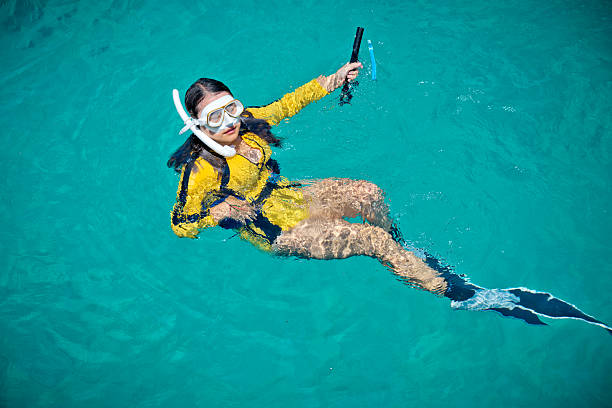Ao explorar o mundo subaquático, as nadadeiras de snorkel são suas companheiras de confiança. Esses equipamentos essenciais fornecem a propulsão necessária para deslizar sem esforço pela água. Entender o que são nadadeiras de snorkel e sua importância é crucial para todo praticante de snorkel. Do aumento da mobilidade à conservação de energia, essas nadadeiras desempenham um papel vital em suas aventuras aquáticas. Vamos explorar tudo sobre nadadeiras de snorkel e abordar brevemente os diversos tipos disponíveis.
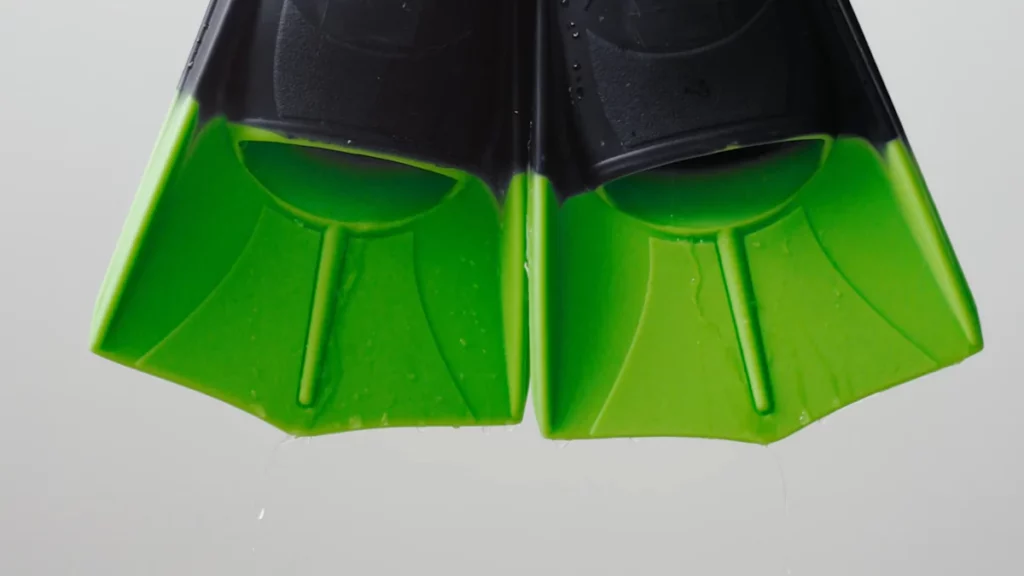
O que são nadadeiras de mergulho com snorkel?
Nadadeiras de mergulho com snorkelEssenciais para qualquer aventura de mergulho com snorkel, as nadadeiras aumentam a propulsão e a manobrabilidade do nadador na água. Elas reduzem o esforço necessário para se movimentar, permitindo que os praticantes de mergulho com snorkel deslizem com suavidade e eficiência. Projetadas com maestria em diferentes estilos, como pé inteiro e calcanhar aberto, essas nadadeiras atendem a diversas condições aquáticas e preferências pessoais. Ao ampliar a potência das pernas e proporcionar melhor controle, as nadadeiras de mergulho com snorkel tornam a experiência mais agradável e ajudam a conservar energia, tornando-as indispensáveis tanto para iniciantes quanto para praticantes experientes.
Tipos de nadadeiras de mergulho com snorkel
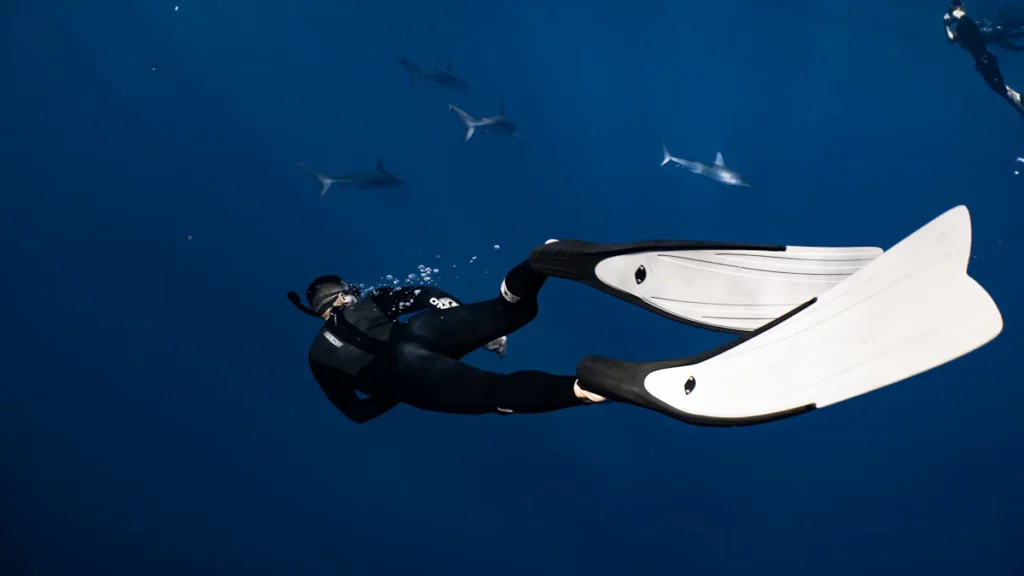
Ao pesquisar o melhor tipo de nadadeira para mergulho com snorkel, é essencial entender as diversas opções disponíveis. Diferentes designs atendem a diferentes preferências e condições, cada um oferecendo vantagens e desvantagens únicas. Aqui está uma análise mais detalhada dos principais tipos de nadadeiras para mergulho com snorkel para ajudar você a fazer uma escolha informada.
Barbatanas de pé inteiro
Nadadeiras de pé inteiro são equipamentos de mergulho com snorkel projetados para cobrir todo o pé, proporcionando um ajuste seguro e confortável. Originárias de meados do século XX, essas nadadeiras revolucionaram a propulsão subaquática, aumentando a eficiência da natação. Feitas de materiais leves, como borracha ou silicone, são ideais para águas quentes. Sua facilidade de uso e portabilidade as tornam populares entre praticantes de mergulho com snorkel casuais e iniciantes, oferecendo uma maneira conveniente e eficaz de navegar em ambientes subaquáticos sem calçados adicionais, como botas.
Prós das nadadeiras Full Foot:
- Fácil de colocar e tirar
- Leve e compacto, ideal para viagens
- Ajuste confortável sem a necessidade de equipamentos adicionais, como botas
Contras das nadadeiras Full Foot:
- Ajuste de tamanho limitado, pode não servir perfeitamente em todos
- Menos proteção contra água fria e superfícies ásperas
- Não é ideal para uso prolongado em condições mais frias
Quem usará
Mergulhadores casuais em águas quentes e tropicais apreciarão a conveniência e o conforto das nadadeiras de pata inteira. Elas são perfeitas para iniciantes devido à sua simplicidade e facilidade de uso. Viajantes geralmente preferem nadadeiras de pata inteira por sua leveza e portabilidade, tornando-as uma excelente opção para aventuras de mergulho com snorkel nas férias.
Barbatanas de calcanhar abertas
Nadadeiras com calcanhar aberto são equipamentos de mergulho com snorkel e com tiras ajustáveis que deixam o calcanhar exposto. Este design permite um ajuste personalizado e o uso de botas de neoprene para maior aquecimento e proteção. Originárias de meados do século XX, com o avanço da tecnologia de mergulho, essas nadadeiras são ideais para diversas condições aquáticas, incluindo ambientes mais frios. Feitas de materiais duráveis como borracha e plástico, elas oferecem versatilidade e conforto, tornando-as as preferidas entre praticantes de snorkel e mergulhadores experientes que buscam adaptabilidade e desempenho em diversos ambientes aquáticos.
Prós das nadadeiras de salto aberto:
- Alças ajustáveis para um ajuste personalizado
- Pode ser usado com botas de neoprene para maior aquecimento e proteção
- Adequado para uma variedade de temperaturas e condições de água
Contras da barbatana de calcanhar aberta:
- Mais pesado e volumoso, o que pode ser menos conveniente para viagens
- As tiras podem se desgastar e podem precisar ser substituídas
- Um pouco mais complexo de colocar e tirar em comparação com nadadeiras de pé inteiro
Quem usará
Nadadeiras abertas são ideais para praticantes de snorkel que frequentam águas mais frias ou condições variáveis, pois podem ser combinadas com botas para maior aquecimento. Mergulhadores e praticantes de snorkel experientes que precisam de um ajuste preciso e valorizam a versatilidade encontrarão vantagens nessas nadadeiras. Elas também são adequadas para aqueles que preferem um conjunto de equipamentos mais ajustável e personalizável.
Barbatanas divididas
As nadadeiras bipartidas são nadadeiras avançadas para mergulho com snorkel e com cilindro, com uma lâmina única dividida ao meio, projetada para reduzir o arrasto e aumentar a eficiência. Desenvolvidas no final do século XX, elas revolucionaram a propulsão subaquática ao imitar o movimento de animais marinhos. Essas nadadeiras são normalmente feitas de borracha ou materiais compostos de alta qualidade, proporcionando maior velocidade e menor fadiga nas pernas. Ideais para mergulhadores e praticantes de snorkel experientes, as melhores nadadeiras bipartidas para mergulho com cilindro oferecem desempenho e conforto superiores, tornando longas sessões subaquáticas menos extenuantes e mais prazerosas.
Prós das nadadeiras divididas:
- O design exclusivo reduz o arrasto e aumenta a eficiência
- Menos tensão nas pernas, tornando-as ideais para sessões mais longas
- Pode melhorar a velocidade com menos esforço
Contras das nadadeiras divididas:
- Podem ser mais caras do que as nadadeiras tradicionais
- Pode exigir um período de adaptação para novos usuários
- Não é tão eficaz para chutes poderosos em correntes fortes
Quem usará
Praticantes de mergulho com snorkel que priorizam a eficiência e a redução da fadiga nas pernas se beneficiarão de nadadeiras bipartidas. Essas nadadeiras são perfeitas para praticantes de mergulho com snorkel experientes que buscam aprimorar seu desempenho e para aqueles dispostos a investir em equipamentos avançados para uma experiência mais agradável. Elas são especialmente preferidas por praticantes de mergulho com snorkel que realizam sessões longas e desejam minimizar o esforço nas pernas.
Barbatanas de remo
As nadadeiras de remo são nadadeiras robustas para mergulho com snorkel e com cilindro, caracterizadas por seu design de lâmina sólida e sem fendas. Desenvolvidas em meados do século XX, essas nadadeiras são conhecidas por sua potência e capacidade de propulsão, tornando-as adequadas para correntes fortes e condições subaquáticas desafiadoras. Normalmente construídas com materiais duráveis, como fibra de vidro ou plástico de alta qualidade, as nadadeiras de remo oferecem excelente durabilidade e desempenho. Elas proporcionam propulsão eficiente a cada impulso, permitindo que praticantes de snorkel e mergulhadores naveguem rapidamente em ambientes aquáticos. As nadadeiras de remo são preferidas por mergulhadores e praticantes de snorkel que buscam máxima potência e controle durante suas aventuras subaquáticas.
Prós das nadadeiras de remo
- Propulsão aprimorada: O tamanho grande das lâminas das nadadeiras Paddle Fins se traduz em chutes poderosos, impulsionando você pela água sem esforço.
- Versatilidade: Adequadas tanto para iniciantes quanto para mergulhadores experientes, essas nadadeiras se adaptam bem a diferentes estilos de natação.
- Durabilidade: Feitas de materiais de alta qualidade, as quilhas de remo oferecem desempenho duradouro, mesmo em condições desafiadoras.
Contras das nadadeiras de remo
- Peso: Devido à sua construção robusta, as nadadeiras de remo podem parecer mais pesadas em comparação a outros tipos de nadadeiras, exigindo mais esforço durante o uso prolongado.
- Flutuabilidade: A maior área de superfície das lâminas pode levar ao aumento da flutuabilidade, afetando seu controle de profundidade durante mergulhos com cilindro ou snorkel.
Quem usará
Mergulhadores que priorizam potência e eficiência em suas excursões subaquáticas se beneficiarão mais com o uso de nadadeiras de remo. Seja explorando recifes de corais vibrantes ou deslizando ao lado da vida marinha em águas abertas, essas nadadeiras proporcionam o impulso necessário para uma experiência de mergulho agradável.
Qual é a diferença entre nadadeiras de mergulho com snorkel e nadadeiras de natação?
Ao comparar nadadeiras de mergulho com snorkel com nadadeiras de natação, é essencial entender suas finalidades distintas em atividades aquáticas. Aqui está uma tabela comparativa entre nadadeiras de mergulho com snorkel e nadadeiras de natação.
| Recurso | Nadadeiras de mergulho com snorkel | Nadadeiras |
| Projeto | Lâminas mais longas e largas | Lâminas mais curtas e compactas |
| Propósito | Melhore a propulsão e a manobrabilidade debaixo d'água | Melhore a técnica de natação e a força das pernas |
| Rigidez da lâmina | Normalmente mais rígido para um impulso mais forte | Mais flexível para permitir o movimento natural do chute |
| Cobertura para os pés | Disponível em modelos de pé inteiro e calcanhar aberto | Geralmente design de pé inteiro |
| Condições da água | Adequado para várias condições de água, incluindo águas abertas | Usado principalmente em piscinas ou ambientes de águas calmas |
| Duração do uso | Projetado para uso prolongado em mergulho com snorkel | Projetado para treinos de curta duração e alta intensidade |
| Eficiência | Maximiza a eficiência na água, reduz a fadiga | Concentra-se em melhorar a forma e a velocidade do nadador |
| Materiais | Feito de materiais duráveis como borracha e silicone | Geralmente feito de borracha mais macia e leve |
| Ajustabilidade | As versões com salto aberto oferecem ajuste com tiras | Ajustabilidade limitada, geralmente design de uma peça |
| Equipamento adicional | Pode ser usado com botinhas (nadadeiras de salto aberto) | Normalmente usado sem equipamento adicional |
| Usuários-alvo | Mergulhadores com snorkel e cilindro | Nadadores, treinadores de natação, entusiastas do fitness |
| Foco no desempenho | Prioriza o controle e a eficiência subaquática | Enfatiza a melhoria da técnica de chute e força |
Em essência, embora ambos os tipos de nadadeiras sirvam como auxílio aquático, a principal diferença reside no uso pretendido. As nadadeiras de snorkel são adaptadas para exploração subaquática, proporcionando maior propulsão e eficiência, adequadas para diversas condições aquáticas. Elas vêm em designs mais longos e mais largos, geralmente com lâminas mais rígidas para auxiliar nas manobras em correntes. As nadadeiras de natação, por outro lado, são otimizadas para uso em piscina, com foco no aprimoramento da técnica de nado e na força das pernas com lâminas mais curtas e flexíveis.
Qual o tamanho de nadadeiras para mergulho com snorkel?
Ao escolher nadadeiras de mergulho com snorkel para suas aventuras aquáticas, é crucial considerar o tamanho que melhor se adapta aos seus pés. As nadadeiras de mergulho com snorkel estão disponíveis em diversos tamanhos para se adaptar a diferentes formatos e tamanhos de pés, garantindo um ajuste confortável e seguro durante suas explorações subaquáticas.
Nadadeiras de mergulho com snorkel para pés largos
Para praticantes de mergulho com snorkel com pés mais largos, optar por nadadeiras integrais pode proporcionar um ajuste confortável e com suporte. Essas nadadeiras são projetadas para envolver todo o pé, oferecendo estabilidade e propulsão enquanto você desliza na água. O design de calcanhar fechado das nadadeiras integrais garante que seus pés permaneçam seguros dentro do bolso da nadadeira, minimizando qualquer deslizamento ou desconforto durante as sessões de mergulho com snorkel.
- Barbatanas de pé inteiro: Ideal para pés largos devido ao seu design envolvente
- Estabilidade: Garante um ajuste seguro para maior manobrabilidade debaixo d'água
- Propulsão: Oferece impulso eficiente para movimento sem esforço na água
Nadadeiras de mergulho para pés finos
Praticantes de mergulho com snorkel com pés mais finos podem achar nadadeiras com salto aberto mais adequadas para suas aventuras aquáticas. Essas nadadeiras possuem uma tira ajustável que permite personalizar o ajuste de acordo com o tamanho do seu pé. Combinar nadadeiras com salto aberto com botas ou meias de mergulho pode aumentar o conforto e o aquecimento, especialmente em águas mais frias, garantindo uma experiência de mergulho agradável.
- Barbatanas de calcanhar abertas: A alça ajustável acomoda pés finos confortavelmente
- Ajuste personalizado: Permite dimensionamento personalizado para desempenho subaquático ideal
- Versatilidade: Adequado para várias temperaturas de água com isolamento adicional
Quer você tenha pés largos ou finos, escolher o tamanho certo de nadadeiras de mergulho com snorkel é essencial para maximizar o conforto e a eficiência durante suas excursões de mergulho com snorkel. Ao selecionar nadadeiras que se adaptam ao formato específico do seu pé, você pode desfrutar de movimentos fluidos na água enquanto explora ambientes marinhos cativantes.
Como usar nadadeiras de mergulho com snorkel? Guia passo a passo
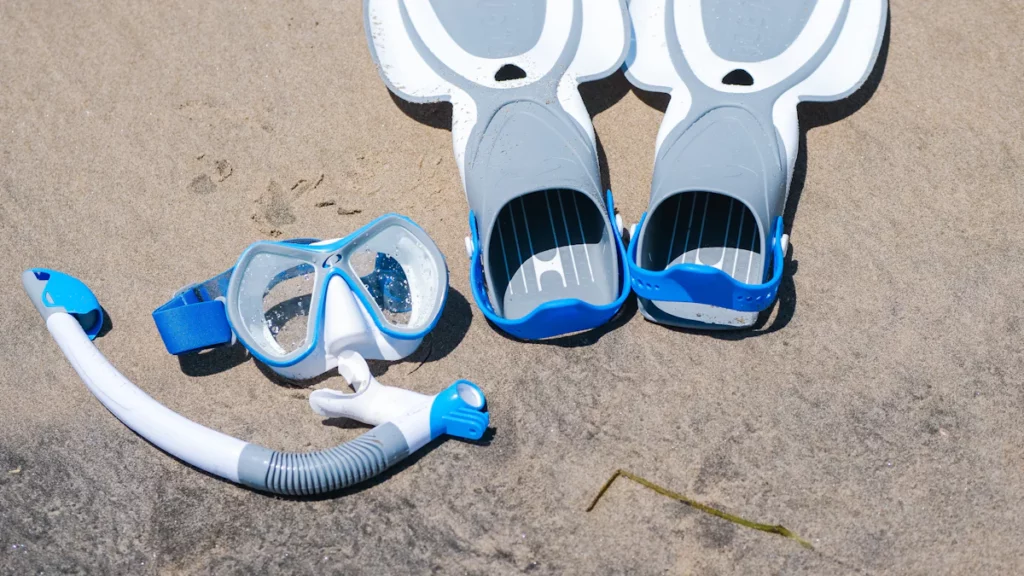
Usar nadadeiras de mergulho com snorkel corretamente pode melhorar significativamente sua experiência subaquática, melhorando a propulsão e reduzindo a fadiga. Aqui está um guia passo a passo para ajudar você a aproveitar ao máximo suas nadadeiras:
Etapa 1: Escolha as barbatanas certas
- Selecione o tipo: Decida entre nadadeiras de pé inteiro ou abertas no calcanhar com base no local de mergulho e na temperatura da água.
- Verifique o ajuste: Certifique-se de que suas nadadeiras estejam justas, mas confortáveis. Elas não devem apertar ou escorregar.
- Teste de conforto: Ande um pouco para garantir que não haja pontos de pressão ou desconforto.
Passo 2: Coloque suas nadadeiras
- Barbatanas de pé inteiro: Basta deslizar os pés nas nadadeiras, garantindo que elas se ajustem firmemente ao redor dos pés.
- Nadadeiras de calcanhar aberto: Calce botas de neoprene, se for usá-las. Deslize o pé na nadadeira e ajuste as tiras até que fiquem justas, mas não apertadas demais.
Etapa 3: Entre na água
- Águas rasas: Coloque as nadadeiras sentado na beira da água. Deslize na água com cuidado para não danificá-las.
- Águas profundas: Entre na água sem nadadeiras e coloque-as enquanto flutua de costas. Se necessário, peça ajuda a um parceiro.
Etapa 4: Domine a técnica de chute
- Chute Flutter: Dê uma batida de perna lenta e constante a partir dos quadris, mantendo as pernas relativamente retas. Evite dobrar os joelhos excessivamente.
- Movimentos suaves: Concentre-se em movimentos suaves e controlados. Chutes rápidos e fortes podem cansar você rapidamente e reduzir a eficiência.
- Prática: Passe algum tempo praticando seu chute em águas calmas e rasas para desenvolver confiança e técnica.
Etapa 5: Navegue com eficiência
- Mantenha seu corpo na horizontal: Mantenha uma posição horizontal para reduzir o arrasto e se mover com mais eficiência.
- Use seus braços: Combine chutes de nadadeira com movimentos suaves dos braços para orientar e manter o equilíbrio.
- Fique relaxado: Mantenha seus movimentos fluidos e relaxados para conservar energia e aproveitar a experiência.
Etapa 6: Cuidados e Manutenção
- Enxágue após o uso: Sempre enxágue suas nadadeiras com água fresca após cada uso para remover sal, areia e outros resíduos.
- Seque adequadamente: Deixe suas nadadeiras secarem ao ar livre em um local fresco e sombreado, longe da luz solar direta.
- Armazene corretamente: Guarde suas nadadeiras em um local fresco e seco, evitando objetos pesados sobre elas para evitar deformações.
Como escolher as nadadeiras certas para mergulho com snorkel? 3 fatores a considerar
Ao escolher boas nadadeiras para mergulho com snorkel, fazer a escolha certa é crucial para uma experiência subaquática confortável e agradável. Entender os principais fatores pode ajudar você a encontrar nadadeiras que atendam às suas necessidades. Aqui estão três considerações essenciais:
Ajuste e conforto
Um par de nadadeiras bem ajustadas, que sejam confortáveis e usáveis corretamente, é essencial. Nadadeiras mal ajustadas podem causar bolhas, cãibras ou até mesmo arruinar sua aventura de mergulho com snorkel. Portanto, você pode garantir que as nadadeiras se ajustem perfeitamente aos seus pés, sem ficarem apertadas demais.
Calcanhar fechado vs. Calcanhar aberto
Ao escolher nadadeiras para mergulho com snorkel, um fator essencial a considerar é se você deve optar por modelos com salto fechado ou aberto. As nadadeiras com salto fechado oferecem um ajuste seguro, envolvendo todo o seu pé, proporcionando estabilidade e propulsão enquanto você explora as maravilhas subaquáticas. Por outro lado, as nadadeiras com salto aberto possuem uma tira ajustável para um ajuste personalizado, ideal para mergulho com snorkel em diversas temperaturas e terrenos.
Importância do ajuste confortável
Garantir um ajuste confortável ao escolher nadadeiras de mergulho com snorkel é fundamental para uma experiência aquática ideal. Uma nadadeira justa evita escorregões e desconforto durante suas aventuras de mergulho com snorkel, permitindo que você se mova sem esforço na água com maior controle e precisão.
Uso pretendido
- Natação de longa distância: Para praticantes de mergulho com snorkel que embarcam em excursões de natação de longa distância, escolher o par certo de nadadeiras é crucial. Opte por nadadeiras que ofereçam propulsão eficiente e conforto por períodos prolongados, permitindo que você percorra distâncias maiores com menos esforço. A escolha certa de nadadeiras pode fazer uma diferença significativa na sua resistência e prazer durante longas sessões de mergulho com snorkel.
- Águas calmas: Ao explorar águas tranquilas ou praticar mergulho de snorkel, considere nadadeiras que ofereçam manobrabilidade sem potência excessiva. Nadadeiras projetadas para águas calmas proporcionam propulsão suave, permitindo que você navegue em ambientes subaquáticos serenos com facilidade e elegância. A escolha das nadadeiras adequadas às condições da água garante uma experiência de mergulho de snorkel tranquila e relaxante.
Marcas populares
Um bom fabricante de nadadeiras de mergulho com snorkel geralmente oferece serviço personalizado e uma solução completa para cada cliente, então você pode comprar nadadeiras de marcas famosas de nadadeiras de mergulho com snorkel.
Vanguarda
Vanguarda A Vanguard se destaca como uma marca conceituada, conhecida por seus designs inovadores e nadadeiras de mergulho de alta qualidade. Com foco em desempenho e durabilidade, a Vanguard oferece uma gama de opções de nadadeiras adequadas tanto para mergulhadores iniciantes quanto para entusiastas experientes. Explore a diversificada seleção de nadadeiras Vanguard para encontrar a combinação perfeita para suas explorações subaquáticas.
Mergulhadores dos EUA
A US Divers se consolidou como uma marca confiável no mundo dos equipamentos de mergulho com snorkel, incluindo nadadeiras de alta qualidade. Reconhecidas por sua confiabilidade e funcionalidade, as nadadeiras da US Divers atendem a diversos níveis de habilidade e preferências, garantindo conforto, eficiência e estilo durante a prática de snorkel em diferentes ambientes marinhos.
Éguas
A Mares se destaca pela tecnologia de ponta e design ergonômico em sua linha de nadadeiras para mergulho com snorkel. Seja para desempenho superior ou conforto excepcional, os modelos inovadores de nadadeiras da Mares atendem a ambos os requisitos. Mergulhe em experiências subaquáticas incomparáveis com o renomado artesanato e a atenção aos detalhes da Mares.
Amika por Aqualung
A Amika by Aqualung combina estilo e funcionalidade em sua coleção de nadadeiras premium para mergulho com snorkel. Projetadas para pessoas que buscam desempenho e estética, as nadadeiras da Amika oferecem uma combinação de elementos de design moderno e recursos avançados. Eleve suas aventuras de mergulho com snorkel com as opções sofisticadas e práticas de nadadeiras da Amika by Aqualung.
Como fazer a manutenção das nadadeiras de mergulho com snorkel?
Para garantir que suas nadadeiras de mergulho permaneçam em ótimas condições para suas aventuras subaquáticas, a manutenção adequada é essencial. Aqui estão algumas dicas práticas para ajudar você a cuidar delas e prolongar sua vida útil:
- Enxágue após o uso:Após cada sessão de mergulho com snorkel, enxágue bem suas nadadeiras com água doce para remover sal, areia e detritos que podem causar danos ao longo do tempo.
- Seque completamente: Deixe suas nadadeiras secarem completamente ao ar livre antes de guardá-las para evitar o crescimento de mofo ou bolor. Guarde-as em local fresco e seco, longe da luz solar direta.
- Inspecione regularmente: Verifique se há sinais de desgaste nas suas nadadeiras, como rachaduras ou tiras soltas. Resolva qualquer problema imediatamente para evitar maiores danos.
- Evite temperaturas extremas: Não exponha suas nadadeiras a calor ou frio extremos, pois isso pode enfraquecer os materiais e afetar seu desempenho.
- Armazene adequadamente: Quando não estiver em uso, guarde suas nadadeiras planas ou penduradas para manter seu formato e evitar deformações.
Conclusão
Em resumo, entender o que são nadadeiras de mergulho com snorkel é essencial para aprimorar sua experiência subaquática. Essas nadadeiras estão disponíveis em vários tipos, cada um projetado para atender a diferentes condições e preferências do usuário. Seja optando por nadadeiras de pata inteira pela simplicidade e conforto, nadadeiras de calcanhar aberto pela versatilidade ou nadadeiras divididas pela eficiência, escolher o par certo é crucial. Lembre-se de considerar fatores como ajuste, conforto e uso pretendido para tomar uma decisão informada. Com as nadadeiras de mergulho com snorkel certas, você deslizará sem esforço pela água, economizando energia e apreciando a beleza do mundo subaquático.
Perguntas frequentes
P1: Como escolher o tamanho certo de nadadeiras para mergulho com snorkel?
Escolher o tamanho certo de nadadeiras de mergulho envolve experimentá-las para garantir um ajuste perfeito, sem apertar. Se comprar online, consulte a tabela de tamanhos do fabricante e leia as avaliações para verificar a precisão do ajuste. Certifique-se de que haja espaço suficiente para movimentar os dedos dos pés sem que as nadadeiras escorreguem.
P2: Posso usar minhas nadadeiras de mergulho com snorkel para mergulho autônomo?
Sim, você pode usar nadadeiras de snorkel para mergulho autônomo, especialmente se elas fornecerem propulsão adequada. No entanto, as nadadeiras de mergulho autônomo são geralmente mais rígidas e robustas, projetadas para mergulhos mais profundos e correntes mais fortes. Considere o tipo de mergulho que você fará para garantir que suas nadadeiras sejam adequadas.
Q3: Quão apertadas devem ser as nadadeiras de mergulho?
As nadadeiras de snorkel devem ficar justas, mas não apertadas demais. Elas devem segurar o pé com firmeza, sem causar desconforto ou restringir a circulação. Você deve conseguir mexer os dedos dos pés e não deve haver pontos de pressão excessivos ou escorregamentos ao se movimentar.
Q4: Preciso de botas com nadadeiras que cubram todo o pé?
Normalmente, você não precisa de botas com nadadeiras que cubram todo o pé, pois elas são projetadas para serem usadas descalças. No entanto, alguns praticantes de mergulho com snorkel preferem usar meias finas de neoprene para maior conforto e evitar atrito, especialmente se forem praticar mergulho com snorkel por longos períodos.
P5: Como posso evitar bolhas nas nadadeiras de mergulho com snorkel?
Para evitar bolhas, certifique-se de que suas nadadeiras estejam bem ajustadas. Usar meias de nadadeira ou aplicar lubrificante nas áreas propensas ao atrito também pode ajudar. Amacie as nadadeiras novas gradualmente com sessões mais curtas de mergulho com snorkel e evite apertar demais as tiras das nadadeiras com salto aberto.
